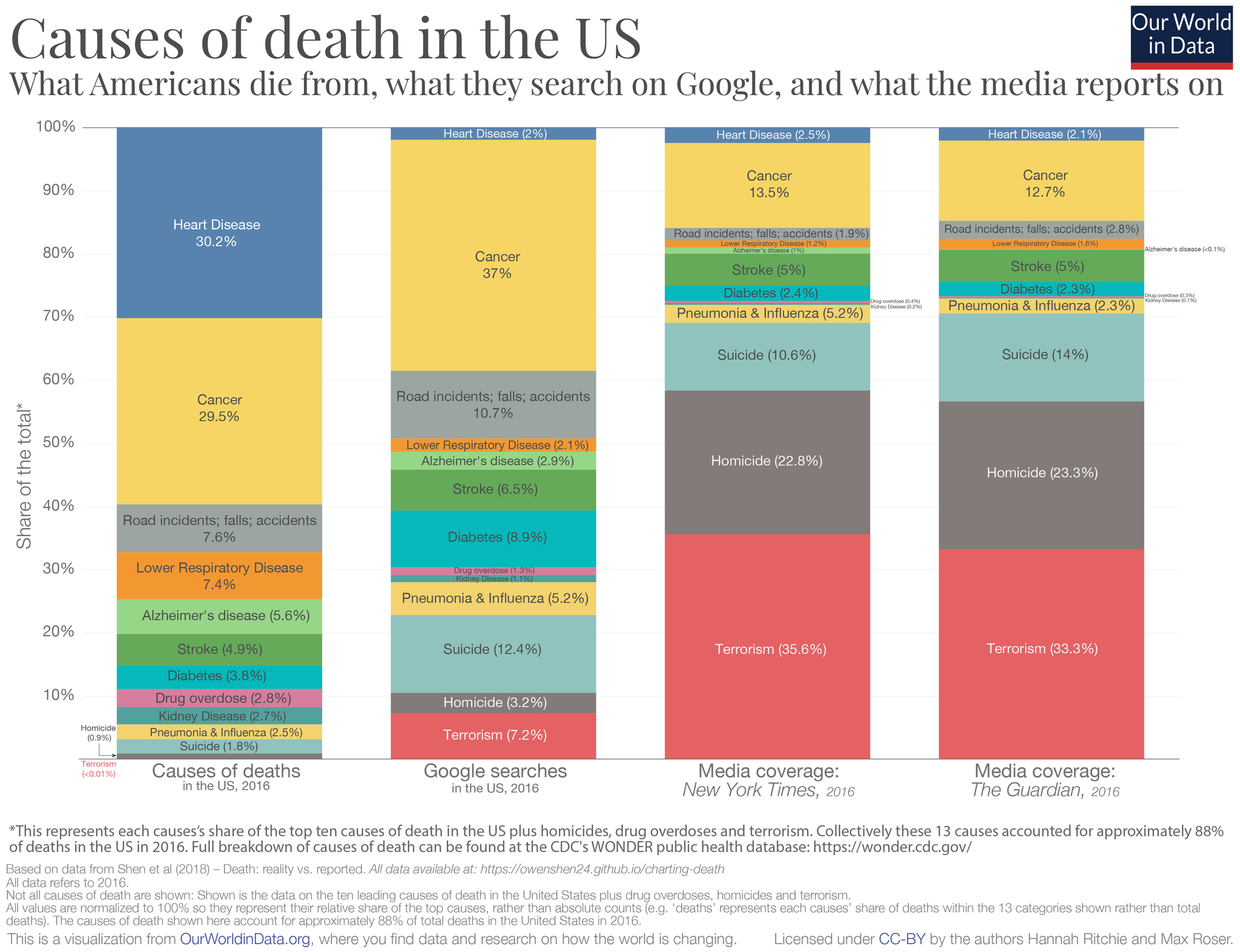More than a century of bad news
Bill Gates recently tweeted the image below, commenting that he is “always amazed by the disconnect between what we see in the news and the reality of the world around us.”

Of course, this chart and Gates’s observation are nothing new – there has long been an accuracy gap between what the news covers (and therefore what Americans believe is important) and what is actually important. As discussed in one academic article on the subject:
The line between journalism and entertainment is dissolving even within traditional news formats. [One] NBC executive [] decreed that every news story should “display the attributes of fiction, of drama. It should have structure and conflict, problem and denouement, rising action and falling action, a beginning, a middle and an end.” … This has happened both in broadcast and print journalism. … Roger Ailes … explains this phenomenon with an Orchestra Pit Theory: “If you have two guys on a stage and one guy says, ‘I have a solution to the Middle East problem,’ and the other guy falls in the orchestra pit, who do you think is going to be on the evening news?”
Matters of policy get increasingly short shrift. In 1968, the network newscasts generally showed presidential candidates speaking, and on the average a candidate was shown speaking uninterrupted for forty-two seconds. Over the next twenty years, these sound bites had shrunk to an average of less than ten seconds. This phenomenon is by no means unique to broadcast journalism; there has been a parallel decline in substance in print journalism as well. …
The fusing of news and entertainment is not accidental. “I make no bones about it—we have to be entertaining because we compete with entertainment options as well as other news stories,” says the general manager of a Florida TV station that is famous, or infamous, for boosting the ratings of local newscasts through a relentless focus on stories involving crime and calamity, all of which are presented in a hyperdramatic tone (the so-called “If It Bleeds, It Leads” format). There was a time when news programs were content to compete with other news programs, and networks did not expect news divisions to be profit centers, but those days are over.
That excerpt feels like it could have been written today. It was not: it was published in 1996. The “if it bleeds, it leads” trope is often attributed to a 1989 New York magazine article – and once introduced into the popular vernacular it grew quickly in popularity:

Of course, the idea that the media sensationalizes its reporting is not a novel observation. “If it bleeds, it leads” is just the late-20th century term for what had been “sex sells” – and the idea of yellow journalism before then. And, of course, “if it bleeds” is the precursor to our more modern equivalent of “clickbait.”

The debate about how to save the press from Google and Facebook … is the wrong debate to have
We are in the midst of a debate about how to save the press in the digital age. The House Judiciary Committee recently held a hearing on the relationship between online platforms and the press; and the Australian Competition & Consumer Commission recently released a preliminary report on the same topic.
In general, these discussions focus on concerns that advertising dollars have shifted from analog-era media in the 20th century to digital platforms in the 21st century – leaving the traditional media underfunded and unable to do its job. More specifically, competition authorities are being urged (by the press) to look at this through the lens of antitrust, arguing that Google and Facebook are the dominant two digital advertising platforms and have used their market power to harm the traditional media.
I have previously explained that this is bunk; as has John Yun, critiquing current proposals. I won’t rehash those arguments here, beyond noting that traditional media’s revenues have been falling since the advent of the Internet – not since the advent of Google or Facebook. The problem that the traditional media face is not that monopoly platforms are engaging in conduct that is harmful to them – it is that the Internet is better both as an advertising and information-distribution platform such that both advertisers and information consumers have migrated to digital platforms (and away from traditional news media).
This is not to say that digital platforms are capable of, or well-suited to, the production and distribution of the high-quality news and information content that we have historically relied on the traditional media to produce. Yet, contemporary discussions about whether traditional news media can survive in an era where ad revenue accrues primarily to large digital platforms have been surprisingly quiet on the question of the quality of content produced by the traditional media.
Actually, that’s not quite true. First, as indicated by the chart tweeted by Gates, digital platforms may be providing consumers with information that is more relevant to them.
Second, and more important, media advocates argue that without the ad revenue that has been diverted (by advertisers, not by digital platforms) to firms like Google and Facebook they lack the resources to produce high quality content. But that assumes that they would produce high quality content if they had access to those resources. As Gates’s chart – and the last century of news production – demonstrates, that is an ill-supported claim. History suggests that, left to its own devices and not constrained for resources by competition from digital platforms, the traditional media produces significant amounts of clickbait.
It’s all about the Benjamins
Among critics of the digital platforms, there is a line of argument that the advertising-based business model is the original sin of the digital economy. The ad-based business model corrupts digital platforms and turns them against their users – the user, that is, becomes the product in the surveillance capitalism state. We would all be much better off, the argument goes, if the platforms operated under subscription- or micropayment-based business models.
It is noteworthy that press advocates eschew this line of argument. Their beef with the platforms is that they have “stolen” the ad revenue that rightfully belongs to the traditional media. The ad revenue, of course, that is the driver behind clickbait, “if it bleeds it leads,” “sex sells,” and yellow journalism. The original sin of advertising-based business models is not original to digital platforms – theirs is just an evolution of the model perfected by the traditional media.
I am a believer in the importance of the press – and, for that matter, for the efficacy of ad-based business models. But more than a hundred years of experience makes clear that mixing the two into the hybrid bastard that is infotainment should prompt concern and discussion about the business model of the traditional press (and, indeed, for most of the past 30 years or so it has done so).
When it comes to “saving the press” the discussion ought not be about how to restore traditional media to its pre-Facebook glory days of the early aughts, or even its pre-modern Internet gold age of the late 1980s. By that point, the media was well along the slippery slope to where it is today. We desperately need a strong, competitive market for news and information. We should use the crisis that that market currently is in to discuss solutions for the future, not how to preserve the past.




